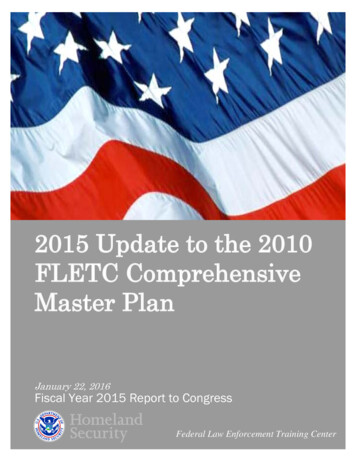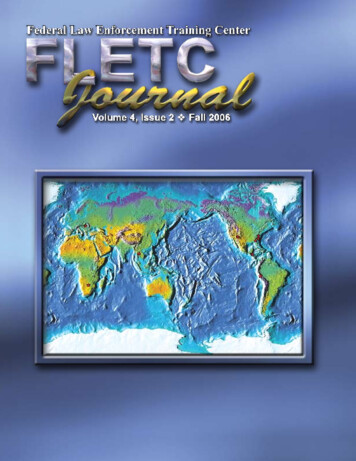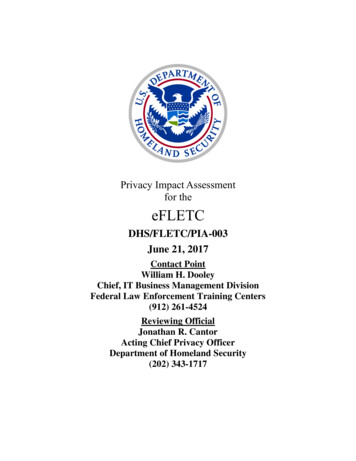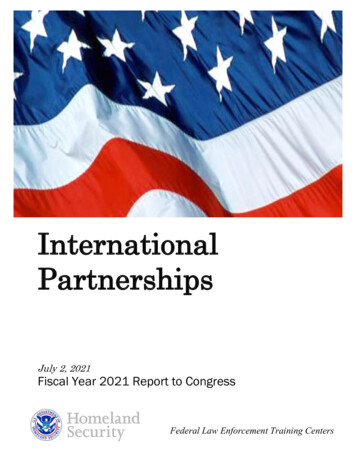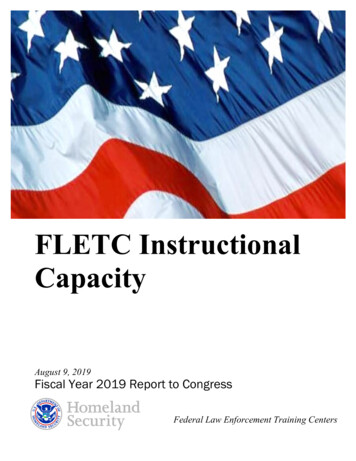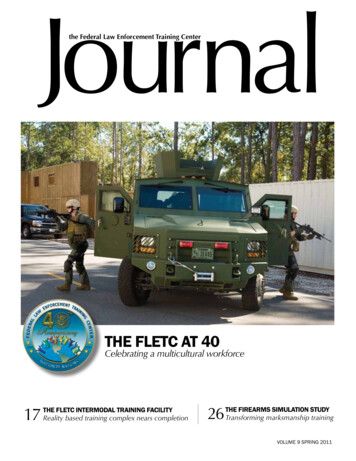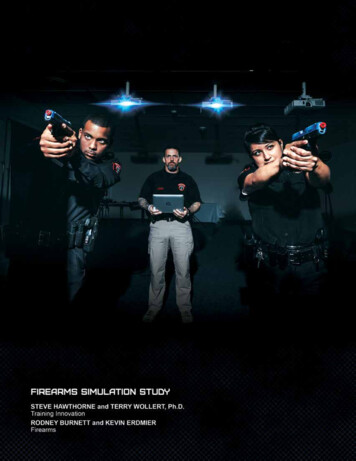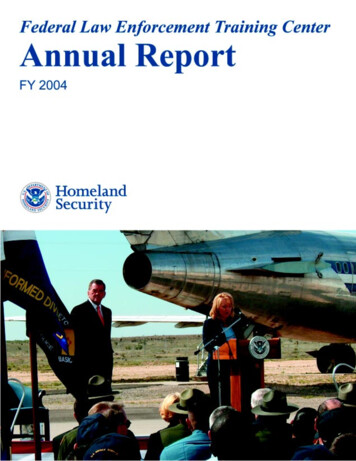
Transcription
The Federal Law Enforcement Training Center (FLETC) madesignificant advances in FY 2004 in support of our nation’shomeland security efforts. Whether developing critically neededcounterterrorism and intelligence analysis training programs for federal,state, and local law enforcement agencies, or applying sophisticatedtechnologies to improve the quality and efficiency of training, the FLETCproved yet again that its leadership role is vital to our nation’s readiness.Whether developingcritically neededcounterterrorismand intelligenceanalysis trainingprograms for federal,state, and local lawenforcementagencies, or applyingsophisticatedtechnologies toimprove the qualityand efficiency oftraining, the FLETCproved yet again thatits leadership role isvital to our nation’sreadiness.Every success the FLETC achieved was the product of strongcollaboration across agencies, departments, and even governments.Working together has always been “the FLETC way.” Since its inceptionin 1970, the FLETC has cultivated strong inter-agency ties. Today, ourpartnership of 81 federal agencies represents the greatest concentration oflaw enforcement expertise in the world, all focused on a single goal: toensure the protection of our homeland.We were very pleased to have the opportunity to showcase ourpeople, mission, and facilities to Homeland Security Secretary Tom Ridgethis past year. His visits to our Glynco and Artesia sites are chronicled inthis report.In addition, this report highlights important training developmentsand other projects that will position the FLETC to meet future missionrequirements. Among these was the establishment of a new TrainingInnovation and Management directorate within the FLETC whose missionis to formalize processes for integrating cutting edge technologies intoFLETC training. These include simulators, web-based training, computerbased training, and distributed learning. Another key development was theinitiation of a project to design and construct a multi-use CounterterrorismOperations Training Facility at Glynco to meet the expanding needs of lawenforcement in the post-9/11 environment.Together with our partners, we look forward to capitalizing on theseand our many other successes of this past year as we enter our thirty-fifthyear as our nation’s leader in law enforcement training.Connie L. PatrickDirectorFederal Law Enforcement Training Centeri
Federal Law Enforcement Training CenterAnnual ReportContentsiiiForeword by Director PatrickContentsTraining Developments1.2.2.2.Intelligence AwarenessLand Transportation Antiterrorism & Critical Infrastructure ProtectionUse of ForceReadiness Training for U.S. Army 3rd Infantry DivisionStrategic Developments4.5.6.7.Formation of Training Innovation and Management DirectorateCounterterrorism Operations Training FacilityInformation Technology UpdateField Site Developments: Cheltenham Dedication Border Patrol Move to Artesia U.S. Coast Guard at Charleston International Law Enforcement Academy - Latin AmericaOther Highlights1.2.3.5.6.8.8.8.DHS Secretary Ridge VisitsLaw Day ObservancePeace Officers Memorial DaySpurgeon Award - Law Enforcement Explorers‘Closing the Circle’ Environmental AwardHonor Graduate of the YearEEO AccomplishmentsTraining Support for Major National EventsTraining Statistics - Back CoverCover: DHS Secretary Tom Ridge prepares to take the podium to address a gathering of students and staff atthe FLETC-Artesia. More on Secretary Ridge’s visits to Artesia and Glynco Page 1.ii
Training DevelopmentsIntelligence Awareness TrainingThe FLETC’s Office of State and Local Training(OSL) entered into a four-year, 3 million Memorandumof Understanding with the Office of State and LocalGovernment Coordination and Preparedness (SLGCP),Office of Domestic Preparedness (ODP), Department ofHomeland Security (DHS).The agreement specifically authorized the OSLto analyze state and local intelligence training needsand to design, develop, deliver, and evaluate intelligence training courses for federal, state, local, campus, and tribal law enforcement officials and other personnel identified by the SLGCP. In addition, the agreement included development of three distinct trainingprograms that target line officers and supervisors, executive level officials, and intelligence analysts in thelaw enforcement community.The OSL and ODP hosted a curriculum development conference Jan. 26-30, 2004, in Washington,D.C., convening over 25 subject matter experts (SME)to develop the curriculum. The SME group quicklyidentified the line officer and supervisor program asthe most immediate need for awareness training. Topics were selected, performance objectives outlined, andlesson plans started. The program was named the AntiTerrorism Intelligence Awareness Training Program(AIATP).On May 24-25, 2004, a conference was held in Atlanta to develop the lesson plans for the training. Subsequently, a pilot program was delivered in Atlanta Aug.10-11, after which several changes were implementedincluding reduction of the program to one day (8 hours).A video/CD entitled Diligence Matters was developedand is given to each student for use as a training toolback at their departments or agencies.The AIATP is delivered as an eight-hour awarenessprogram for line officers and supervisors. The programis delivered in two, one-day sessions at each geographiclocation to accommodate as many law enforcement officers as possible. Sessions are planned for the 50 largestcities in the U.S. in the next two years.Ridge VisitsHomeland SecuritySecretary TomRidge made twotrips to the FLETCin 2004. He visitedthe FLETC’s Glyncoheadquarters March25, then theFLETC’s Artesia,N.M., campus April20. At both sites hetoured facilities andtook time to addresslarge gatherings ofstudents and staff.His remarks focusedon the importanceof consolidatedtraining and how itleads to the kind ofunity of effortneeded to combatterrorism.Secretary Ridge at Glynco1
Land Transportation Antiterrorism& Critical Infrastructure TrainingLaw Day ‘04On May 3, 2004, theFLETC held its first everLaw Day observance.Homeland SecurityGeneral Counsel Joe D.Whitley visited Glyncoand spoke at aluncheon attended byJoe Whitleymany FLETC andPartner Organizationstaff and local dignitaries, includingjudges and other members of thelegal profession.In support of the DHS mission to lead a unified effortto secure America, the FLETC Counterterrorism Divisionconducted seven Land Transportation Antiterrorism Training Programs (LTATP) and three Critical Infrastructure Protection Training Programs (CIPTP) in FY 2004The LTATP is a one-week program designed to trainlaw enforcement officers how to protect land transportation infrastructure including rail, mass transit, and busoperations. The program emphasizes antiterrorism planning and prevention.The CIPTP is also a one-week program designedfor those who are responsible for protecting infrastructure essential to national security. The training includesboth physical and cyber-based systems.Law Day has been an Americantradition for over 40 years. The ideaof Law Day was originally inspired byCold War opposition to the SovietUnion’s annual May Day militaryparade. In 1958, PresidentEisenhower declared Law Day as acelebration of our national heritage ofliberty, justice, and equality under thelaw. In 1961, Congress officiallydesignated May 1 as the date forcelebrating Law Day in the U.S.Use of Force TrainingThe FLETC developed and implemented Use ofForce (UOF) programs designed around a combinationof lecture and practical exercises. The programs permitstudents to function in a reasonable and legal mannerwhen faced with a myriad of UOF scenarios. The UOFcurriculum is an integrated part of all FLETC basic training programs. The UOF basic program provides increasedreaction time and instant feedback, while instilling confidence in the students that they will react appropriatelywhen confronted with field situations.Advanced UOF training programs were developedand implemented that focus on using dynamic and interactive training principles. Students learn via demonstration and hands-on participation. Training focuses on legal aspects, mental preparedness, UOF applications, response tactics, documentation, written analysis, court testimony, use of expert witnesses, and training development. Advanced programs include the UOF InstructorTraining Program, UOF for Managers Training Programs,and the UOF User Training Program.Fort Stewart, Ga. The Army requested the FLETC’s support in preparation for the unit’s redeployment to Iraq.During the initial stages of “Operation Enduring Freedom”, the 3/7 Infantry played a major role in the Battleof Baghdad. The unit specifically requested environmentsand facilities that would accommodate urban operationstraining. The primary training objective was to allow seasoned soldiers to share their knowledge and experienceto new members of the unit who had not been to Iraq.They also requested training in the areas of improvisedexplosives, suicide bombers, UOF, firearms, and crowd3rd Infantry Division Trainingcontrol, which the FLETC delivered. The FLETCCounterterrorism, Firearms, and Forensics and InvestiThe FLETC provided training and logistical sup- gative Techniques Divisions worked closely with the unit’sport for members of the U.S. Army’s 3rd Infantry Divi- officers and non-commissioned officers to ensure theirsion – 3rd Battalion, 7th Infantry Regiment, stationed at training goals and objectives were met.2
Peace Officers MemorialThe FLETC hosted its 19th Annual Peace OfficersMemorial Day Ceremony at Glynco May 19, 2004. It wasa day to honor the 135 former FLETC basic traininggraduates and thousands of other Federal, state, andlocal law enforcement officers who have died in theline of duty over the years.Each year the ceremony is conducted jointly withPartner Organization staff and area state and local lawenforcement agencies. It is often attended by familiesof slain officers. Keynote speaker for the 2004ceremony was Border Patrol Deputy Chief RobertHarris.Sadly, this year two names were added to the FLETCGraduates’ Memorial: James P. Epling, Border Patrol;and Duane P. McClure, National Park Service.3
Strategic DevelopmentsTraining Innovation and ManagementThe FLETC established a newdirectorate in FY 2004 to align certain training management and supportfunctions and to promote innovationin training, especially through the integration of alternative technologiesthat can make training more effective,economical, and available. The newTraining Innovation and Management(TIM) Directorate is charged with:NAVAIR AgreementIn April 2004 theFLETC signed a Memorandum of Agreementwith the Naval Air Warfare Center Training Systems Division (NAVAIR) inOrlando, Fla. NAVAIR isa consortium of military,industrial, and academicinstitutions created to improve training throughtechnology, especiallysimulation and modeling.The FLETC-NAVAIRagreement will facilitatethe exchange of information and technology between the military services and the FLETC, andthe FLETC will provide atest bed for trainingprojectsdevelopedthrough jointly-sponsoredresearch. A FLETC liaison officer has been assigned to the NAVAIRcomplex in Orlando toensure a productiveimplementation of thisagreement.Practical ExerciseAssessment System Providing uniform, consis- (PEAS)tent, enterprise-wide management ofthe FLETC’s training programs, including allocating training capacityamong Partner Organizations, administering the processes for trainingprogram development and management, and coordinating the FLETC’sinternal accreditation program; Promoting the innovative enterprise-wide development and integration of alternative training technologies, especially simulation andmodeling, to augment the FLETC’sexisting training delivery systems andmethodologies; Providing strategic oversightof the FLETC’s efforts to expeditiously acquire and implement a Student Administration and SchedulingSystem; Continuing to provide superior student and staff support to facilitate FLETC and Partner Organization training operations; Refocusing the FLETC’s elearning efforts to better supporttraining activities and ensure alignment with the FLETC’s primary mission.Existing divisions aligned under TIM include the Media Support, Research and Evaluation, Student Services, and Training Management and Coordination.A newly formed Training Innovation Division within TIM is responsible for producing or evaluating and acquiring cutting-edge,unconventional alternatives for application in law enforcement training. These non-traditional tools include computer modeling, trainingsimulators, and distributed learningsystems such as web- and computer-based training.4The FLETC implemented aninnovative training solution thatapplies personal digital assistanttechnology to training evaluation.PEAS improves the consistencyand ease with which students areevaluated during practicalexercises. PEAS provides forcentralized storage of scenariodocumentation and studentevaluations, enabling convenientinstructor access during fieldevaluations.Online Survey SoftwareAnother innovative trainingsolution uses web-basedtechnology to conduct trainingrelated surveys as part of thecontinuous validation process. Byusing customized on-line surveysoftware, graduates can providefeedback about their training bycompleting a program-tailoredsurvey on the internet. Thesoftware is also used to conductother specialized surveys,including needs analyses, andcustomer/employee satisfaction.CD/DVD Cross-trainingfor ICEThe FLETC assisted Immigrationand Customs Enforcement (ICE)with an initiative to provide “OneFace at the Border” training for ICEfield agents. The FLETC taped over100 hours of training andconverted it to CD, DVD, and betavideo so it could be deliveredquickly and efficiently throughoutthe ICE organization. The jointproject saved ICE 60,000 in directcost outlays and led to costavoidance of several milliondollars that would have beennecessary for travel and lodgingfor over 5,000 ICE special agentsfor residential training.
Counterterrorism OperationsTraining Facility (CTOTF)In response to changing mission requirements in thepost-9/11 environment, the FLETC initiated, in conjunction with its 81 Partner Organizations, the design, development, and construction of a Counterterrorism Operations Training Facility (CTOTF) at Glynco. Upon completion, the CTOTF will consist of a 220-plus acre site dedicated to providing a realistic training environment toenhance the nation’s capabilities to combat terrorism.The CTOTF is composed of six different environments – urban, suburban, rural, intermodal, international,and underground infrastructure systems – designed toreplicate both foreign and domestic settings. It will offera variety of training venues, such as apartments, rowhouses, neighborhoods, schools, federal buildings, embassy, roadways, and public transportation. It will includeclassrooms and tactical facilities. Situated on a secure site,these facilities will meet the current and emerging trainingneeds of federal, state, and local law enforcement agencies.Significant accomplishments associated with theCTOTF project in FY 2004 include:Explorer AwardThe FLETC received the William H. Spurgeon IIIAward for its support of Law EnforcementExploring. The Award was presented at thebiennial National Explorer LeadershipConference in Atlanta in July 2004.During the past 20 years, the FLETC has been asponsor of Law Enforcement Explorer posts atits facilities in Glynco, Ga., and Artesia, N.M.The post in Artesia currently has a highmembership and is one of the most active anddynamic posts in the Southwest. In addition,the FLETC has been a host for a number ofevents for Law Enforcement Explorer Posts inGeorgia and Florida. Over the years the FLETChas worked with the International Associationof Chiefs of Police to develop study guides forExplorer competitions and has producednumerous videos in support of Exploring. Completion of a Training Needs Assessment Survey of our 81 Partner Organizations which validated theneed for the facility; Presentations to senior officials, including theDHS Secretary, Border and Transportation SecurityUnder Secretary, agency and bureau heads, and Congressional delegations; Dedication of staff, acreage, and facilities; Environmental assessment; Design of the intermodal and international training sites; and Initial construction.FLETC Director Patrick said, “Exploring equipsyoung people with a healthy understandingand respect for the role of law enforcement.This blends perfectly with the FLETC mission –to produce highly proficient law enforcementofficers and agents for our nation. TheFLETC’s relationship with Exploring over theyears has yielded positive benefits for both.”Of particular note, the U.S. Air Force Office of Special Investigations contributed significant funding towardthe project in FY 2004. In addition, the FLETC acceptedsignificant gift donations and commitments from privateentities in support of the intermodal site, such as a 727aircraft from FEDEX and railcars and tracks from Norfolk Southern.The CTOTF will provide consistency and standardization of training practices and procedures for the Partner Organizations. At least 13 Partner Organizations currently deploy recent graduates overseas in direct support of the Global War on Terrorism.The Spurgeon Award was developed by theNational Exploring Committee in 1971 in honorof the man who is regarded as the architect ofthe contemporary Exploring program. LawEnforcement Exploring is one of the officialprograms of Learning for Life, a branch of theBoy Scouts of America that teaches youngpeople about various career opportunities.Photo: FLETC Director Connie Patrick (centerleft) accepts the bronzed eagle award.5
Environmental ExcellenceInformation Technology UpdateThe FLETC received the 2004 PresidentialClosing the Circle Award for environmentalstewardship. This award recognizesoutstanding contributions of federal agenciesin environmental management. The FLETCwas recognized under the Waste/PollutionPrevention category for its leadership indriving the development, procurement, andimplementation of so-called “green”ammunition – or Reduced Hazard Ammunition(RHA) – for use in its firearms trainingprograms. The use of RHA, which ismanufactured using non-lead materials,greatly reduces the health and environmentalrisks associated with the use of traditionallead ammunition and does not denigrate thequality oftraining.Information sharing is vital to DHS. ConsistentInformation Technology (IT) policies and standardsand consolidated IT infrastructure are required. TheFLETC actively assisted DHS in achieving the “OneNetwork – One Infrastructure” vision in FY 2004. TheFLETC provided leadership and technical expertise andwas active in numerous working groups, includingHuman Capital, Security, Infrastructure Transformation, Wireless Network, and many others.Key advances on the IT front include: The FLETC made effective use of the IT portfolio system to budget and fund IT requirements. The ITportfolio assists in evaluating, selecting, and controllingIT investments that best support the agency’s mission.The FLETC IT portfolio strongly aligns to the DHS ITportfolio while also supporting the FLETC’s unique lawenforcement training mission. This leads to efficient andeffective communication, coordination, and reporting.The FLETCexpendsapproximately20 millionrounds ofammunitionper year on 54ranges at itsfour trainingsites aroundthe country –a numberexceededonly by themilitary.An assortment of lead-free ammo.Since theRHA projectbegan in 1998, the FLETC has reduced theamount of lead-containing ammunition that ituses by 75 percent, eliminating some 70,000pounds of lead from the waste stream, with aneventual goal of 100 percent reduction. Using the IT portfolio framework and DHS working group relationships, the FLETC developed strongbusiness cases for many critical projects, including a newfacility maintenance and management system, classroomIT upgrades, audio/video upgrades, remote control technology, and raid house audio/video upgrades. The potential benefits of wireless technologiesto law enforcement training are tremendous. With thesupport of DHS, the FLETC coordinated a comprehensive wireless requirements analysis at all FLETC sites.This included interviewing all FLETC training and support divisions and Partner Organizations. Based upon current and future radio and wireless needs, a comprehensive wireless requirements analysis was created. TheFLETC continues to work with DHS to obtain the necessary resources to modernize this critical IT capability.In 1998, no specifications existed for “green”ammunition. The FLETC worked withmanufacturers to produce RHA having thesame performance characteristics astraditional ammunition but without theassociated health, safety, and environmentalrisks. The FLETC supported productdevelopment with 43 million in contracts nowused by 34 agencies. Manufacturers nowproduce viable RHA in nearly every caliber. The FLETC Chief Information Officer Directorate played a key role in conducting a comprehensiveFLETC Integrated Access Control security analysis thatencompassed both physical and IT security controls atall FLETC sites. Through the review of current strengthsand challenges, specific actions to enhance the FLETC’sIntegrated Access Control security posture have beenidentified and prioritized.Since then, due to the FLETC’s leadership andthe volume of demand for ammunition itgenerates, the per-round cost of RHA hasdropped considerably, in some cases by asmuch as 48 percent.6
Field Site DevelopmentsCheltenham DedicationCBP-Border Patrol Move to ArtesiaThe dedication and grand opening of the FLETCOn Aug. 19, 2004, U.S. Customs and Border ProCheltenham was held on Sept. 20, 2004. Over 300 fed- tection Commissioner Robert C. Bonner announced thateral, state, and local law enforcement personnel and gov- the Border Patrol Academy, which trained new agents aternment officials attendedGlynco as well as inthe ribbon cutting cerCharleston, S.C., would beemony. Principal speakersconsolidated at theincluded CongressmanFLETC’s state-of-the-artthSteny Hoyer, 5 Congrestraining facility in Artesia,sional District of Maryland;N.M. The first Border PaHomeland Security Undertrol training class began atSecretary for Border andthe FLETC-Artesia Oct.Transportation Security21, 2004.Asa Hutchinson; andFLETC Director ConniePatrick.Coast GuardThe FLETC-Cheltenat Charlestonham serves as a firearmsand vehicle operations re- FLETC Director Patrick (center) prepares to cut the ribbonThe United Statesqualification facility for tens at Cheltenham. She is flanked by Under SecretaryCoastGuard commisHutchinson (left) and Congressman Hoyer (right). Joiningof thousands of federal of- them are (from far left) Bob Smith, Deputy Assistantsioned its Maritime Lawficers and agents assigned Director, Office of Cheltenham Operations; Jim Dyer, Staff Enforcement Academyto the Washington, D.C., Director, House Committee on Appropriations; Marilynn(MLEA) on Dec. 1, 2004.area. Located on the site Bland, Councilwomen, Prince George’s County, Md.; andThe ceremony took placeof the former Naval Com- Thomas V. “Mike” Miller, President of the Maryland Stateat the FLETC-Charleston.Senate. Seated on the dais are the Rev. Stephen Short,munications Detachment in Chaplain, DC Metropolitan Police Department, and StanThe MLEA combines thePrince George’s County, Moran, Deputy Assistant Director, FLETC Office of StateCoast Guard’s two previMd., the 372-acre facility and Local Training (far right).ous training programs, thealso houses the U.S. CapitolMaritime Law EnforcePolice Training Academy.ment School in Yorktown,The FLETC was given a mandate by Congress in Va., and the Boarding Team Member School in Petaluma,2000 (Public Law 106-346) “to establish and operate a Calif., into one single facility co-located with the FLETCmetropolitan area law enforcement training center.” Charleston.Working closely with stakeholders, the FLETC adaptedthe facility to its new mission, through extensive renovaILEA Latin Americation, expansion, and new construction. The FLETCCheltenham boasts state-of-the-art driver and indoor fireOn Nov. 3-7, 2003, the FLETC conducted aarms ranges and many other support structures. The facility is designed to support non-residential training of Training Needs Assessment Conference for an International Law Enforcement Academy (ILEA) Latinrelatively short duration.Concurrent with the start up of Cheltenham opera- America. The Conference was held in Quito, Ecuations, numerous federal, state, and local law enforcement dor, and drew attendees from 18 Central and Southagencies utilized vacant buildings and classrooms for tac- American countries and 22 law enforcement organitical and other academic training while the FLETC’s train- zations. Following the Training Needs Assessment, theing venues were under construction. The student through- next step to establish an ILEA Latin America was aput for this in-service, agency-specific training totaled Key Leaders Conference scheduled for December 2004in Panama City, Panama.15,299 student days, or 3,060 student weeks.7
Honor GraduateThe FLETC’s Honor Graduate of the Year Award for2003 went to National Park Service Ranger Edward J.Visnovske. This award is presented annually to theFLETC basic training graduate having the highestacademic average. Ranger Visnovske graduated fromthe FLETC’s National Park Ranger Integrated programon Aug. 25, 2003, achieving a 98.79% academicaverage, outscoring some 8,745 other basic traininggraduates during the year. Ranger Visnovske alsoexcelled at firearms qualification and physical fitness.FLETC Director Connie Patrickpresents Ranger Visnovskewith an award certificate.At a luncheon in his honor at Glynco Oct. 7, 2004,Ranger Visnovske received a Sig Sauer Model 239, 40caliber, semiautomatic pistol. The award is madepossible by a generous gift by Aubrey A. “Tex”Gunnels, formerly Clerk to the Treasury, PostalService, and General Government Subcommittee,House Committee on Appropriations. Mr. Gunnels wasinstrumental in the establishment of the FLETC in1970. He remains involved with the FLETC through theHonor Graduate of the Year program.Other HighlightsEEO Accomplishmentssupported the intern program.ADA Training – The FLETC sponsored two fourhour management seminars on liability issues associatedwith the Americans with Disabilities Act.ASL Training – The FLETC sponsored four 10week classes on American Sign Language and six twohour classes on workplace sign language and deaf culture issues and etiquette.The FLETC Equal Employment Opportunity Office completed a number of projects, including:Black History Month – Staff luncheon Feb. 25, 2004;Guest speaker Rear Adm. Stephen W. Rochon, U.S. CoastGuard.Women’s History Month – Staff breakfast March11, 2004; Guest speaker Col. Adrian Frasier-Darling, U.S.Marine Corps.Diversity Training – The FLETC-Cheltenham helda “Heritage Encampment” in June. The four-day culturalfair allowed FLETC staff to learn about the many peopleswho contributed to the development of a uniquely American culture, through live presentations and authentic displays. Similar encampments are held annually at eachFLETC site. The events are also available to local schoolchildren and residents. The purpose is to promote unityand build corporate strength among diverse groups.Internship – The FLETC placed a Student-withDisabilities intern within the Driver and Marine Divisionin FY 2004. This is the third year that the FLETC hasTraining Support forMajor National EventsDuring FY 2004, the FLETC’s Forensics and Investigative Techniques Division, Driver and Marine Division and the Counterterrorism Division provided training support to federal, state, and local agencies with keysecurity and law enforcement roles for the G-8 Summitheld on Sea Island, Ga., the Democratic National Convention in Boston, the Republican National Conventionin New York, and the Free Trade Area of the AmericasConference held in Miami.8
Training StatisticsStudents Graduated - Fiscal Years 1970-200444,81150,00032,092 33,21940,00024,044 23,326 �00‘01‘02‘03‘04FY 2004 Student Weeks TrainedPer 03%Charleston14,89610%Cheltenham5,0233%FY 2004 Student Weeks TrainedTop Ten 5,705 5,5595,518 5,397 5,0363,999 c Affairs OfficeFederal Law Enforcement Training CenterGlynco, GA 31524(912) 267-2447www.fletc.govTSAABI
Training Developments 1. Intelligence Awareness 2. Land Transportation Antiterrorism & Critical Infrastructure Protection 2. Use of Force 2. Readiness Training for U.S. Army 3 rd Infantry Division Strategic Developments 4. Formation of Training Innovation and Management Directorate 5. Counterterrorism Operations Training Facility 6. Information .

